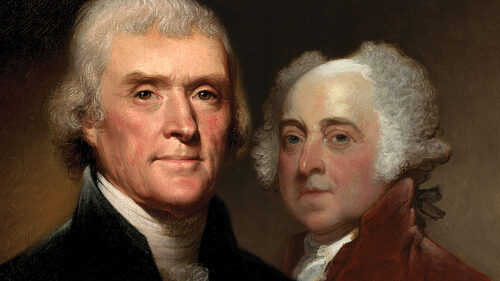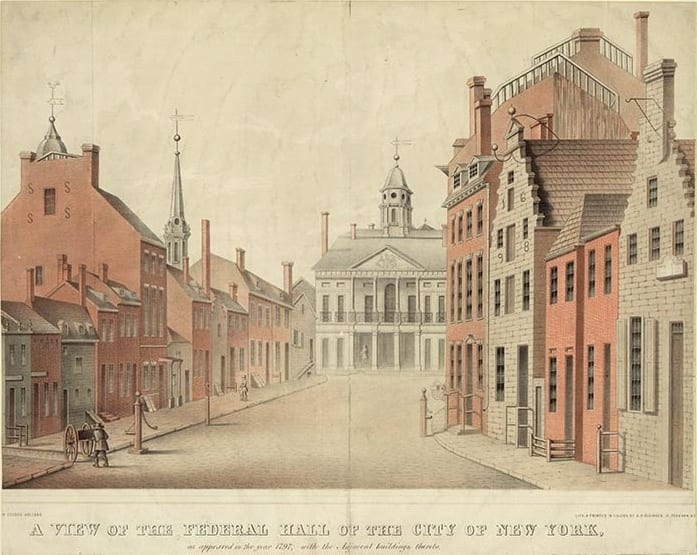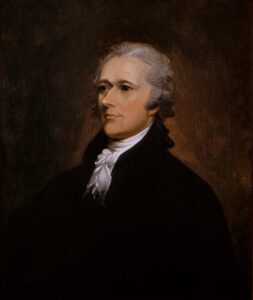
From Bullets to Ballots: The Election of 1800 - Ch. 3
Avoiding Partisanship
- The Confidence of Unchallenged Federalism, 1789-1791
- The Hamiltonian Financial and Industrial Project
As we have seen, there was great reluctance among many American political leaders in the 1780s to contemplate, much less to encourage, the introduction of partisanship into national politics. Parties of interest (“factions”) were only to be expected, but such parties were to be involved in legislative deliberations only as “interested parties” who could not be allowed to be judges in their own cause by determining the outcome of those deliberations. Parties of principle, on the other hand, were to be avoided altogether, for a number of reasons.
In addition to the reasons against parties of principle that we have already looked at, and as a way of encapsulating many of these reasons, it is possible to compare the American polity in the 1780s and 1790s with other modern new nations that have come out of revolutions and wars of independence. Such nations often share with their American precursor a mixture of confidence with much uncertainty and anxiety about their political future, along with great dependence on one or more of the world’s greater and more established political powers. In such circumstances, even where there are precedents for peaceful and respectable principled democratic partisan conflict (there were none in the United States, which was in the process of creating the first such precedent), politicians will generally be reluctant to disrupt the nation’s political solidarity. Therefore there is an instinctive opposition to principled political opposition in such modern new nations. This helps to explain the bitterness and depth of party animosities once they do emerge.
This characteristic feature of new nations was even more deeply rooted in the United States than in later new nations. In the first place, the union of the states, already stretching across a large and diverse part of the North American continent, was a recent and fragile creation, and its future looked very doubtful to many observers. Furthermore, it was not just the fate of this particular country that was being determined by its political success or failure. The United States, as the first modern democratic republic, was from the very beginning considered by its leading statesmen to be (as Jefferson was to put it in his First Inaugural Address) “the world’s best hope.” Pinning that hope on party government—that is, on the possible respectability of partisanship—rather than on a national political solidarity that ruled out that possibility, was a great innovation. It was a step that called for serious consideration before proceeding. The American party system has proved to be an object of scorn and derision to many foreign observers, rather than something to be learned from and perhaps in some ways emulated. Those critical observers may well be misinformed or mistaken in their judgments, but the fact remains that the founding of the American republic, if it endured, seemed to the founders to be a more certain way of gaining fame and the gratitude of later generations of liberty-loving people than was the founding of the American party system. There was—and continues to be—something less admirable in partisanship than in patriotism. No American founder ever suggested “father of the American party system” as a desirable epitaph.
One characteristic of all new regimes that adds to the anxieties surrounding partisanship within them is the issue of relating the present to the past. Questions will always arise about the risk of slipping back into the old ways. This risk, however exaggerated it might be, will always be plausible, because there will always be some continuity, so the question will arise: which of these ties to the old regime should be kept, and which regarded as damaging to the new regime? In the United States, as in other post-colonial new democracies, this issue took the form of troubled political, economic and cultural relations with the “mother country.”
The Confidence of Unchallenged Federalism, 1789-1791
Although there were some doubts and anxieties in the minds of the advocates of the new Constitution, and there would soon come to be many more, Federalists enjoyed a few years of relative calm and confidence. They saw public opinion running in their favor at least from 1787 onwards, when they saw (as Hamilton wrote in The Federalist Number 26) that “experience has wrought a deep and solemn conviction in the public mind, that greater energy of government is essential to the welfare of the community.” To some extent, such judgments about public opinion may have been products of wishful thinking: Federalists did not commission public opinion surveys. In spite of Federalists’ soundings to the contrary, it may have remained true that (as a French diplomat in America commented in 1790) “the people” were “less disposed in America than anywhere else to provide for the needs of government.” However, there were in the late 1780s and early 1790s many public expressions of the denial of the idea that strengthening the government meant weakening the people’s liberty. As mentioned, there were also several other important developments that justifiably boosted Federalists’ confidence. The elections of 1788 produced a congress that was decidedly Federalist, the new government got itself up and running without any serious hitches, and the agreement on the promised bill of rights was reached expeditiously in 1789.

As well as the confidence encouraged or at least allowed by these practical political circumstances, we need to take notice of the confidence inherent in Federalist political thought in the years before the Republican party arose and challenged and eventually defeated the Federalists in office. Federalists’ thinking about politics in general and American politics in particular is known for its realism, but Federalists’ realism fuelled confidence rather than despair. This distinguished them from many Anti-federalists, whose thinking was full of despair for the future, so much so that it helped demoralize their efforts to prevent ratification of the Constitution. Anti-federalists’ gloomy political despair was also an important point of difference between them and the determinedly optimistic and confident Jeffersonian Republicans. Jeffersonian confidence is well known, and it is a hallmark of Jefferson’s liberal descendants in American political thinking. But the fact that optimism and confidence were also marks of Federalism in its early years is less well remembered, because many Federalists would eventually become less optimistic about their political project and about America’s future. As we shall see, a few of them even abandoned their faith in the principles of American democracy, so they are now remembered for this rather than for their earlier optimism. The earlier optimism must be taken into account in order to understand the projects and policies that led the Republicans to challenge them.
We can see the confidence of this early Federalist political thought in two topics that we have already touched upon: the need for energetic executive power in republics, and the usefulness of largeness and diversity in the task of keeping parties of interest in their place.
The Federalists’ case for a unified, adequately empowered executive with a relatively long (four-year) term of office and no limits on re-eligibility was part of a realistic reconsideration of the traditional whig hostility to executive power. It was realistic because it was based on Americans’ real experiences in the 1770s and 1780s. It could be described as a retreat from traditional whig and American idealism about the virtues of the people and their immediate representatives in legislatures, in contrast to executive office holders, who always had to be assumed to be up to no good. However, it was equally a statement of great confidence in a president who was to be properly armed with authority but who was also elected and who would be assessed and held to account by having to stand for re-election and by the judgment of history.
The Federalists’ case for a large, diverse republic was assuredly a rejection of those idealistic, overconfident “theoretic politicians” who are criticized by Madison in The Federalist Number 10 for advocating a “pure democracy” rather than representative democracy. And, like the Federalist revision of the character of a republican executive, it could also be described as a retreat from a kind of idealism or romanticism about popular virtue that had been more appealing and influential during the Revolution (and that was still being voiced by some Anti-federalists), an idealism that assumed that threats to liberty will always come from government rather than from the people. In 1787 Madison reported this change to Jefferson (who was then in Paris serving as the American minister to France): in America, in contrast to France, it was being realized, said Madison, that “the invasion of private rights is chiefly to be apprehended, not from acts of government contrary to the sense of its constituents, but from acts in which the government is the mere instrument of the major number of their constituents.” But these realistic thoughts about the limits of popular virtue were also an assertion of confidence that (as Madison said in the Virginia ratifying convention in 1788) “the people will have virtue and intelligence to select men of virtue and wisdom” to the House of Representatives and the Senate, and therefore that (as we have already seen him arguing in The Federalist Number 10) those who are elected to the federal congress will be more likely than those elected to state legislatures to be wise, patriotic and just; and, furthermore, that federal representatives would be well positioned to avoid becoming mere registers of unjust pressures from their constituents.
The Hamiltonian Financial and Industrial Project
The confidence of Federalist political thought in the years between the Federalists’ battle against Anti-federalists and their conflicts with Republicans can also be seen in the Hamiltonian financial and industrial project. Alexander Hamilton, as the first Secretary of the Treasury, articulated this project in his official reports on public credit (1790) and manufactures (1791). The proposals that Hamilton incorporated in these reports amounted to a plan to use the newly energized federal government to promote the development of the American economy. The presentation of this project triggered an unexpected quantity and kind of political opposition. Opposition to Hamilton’s economic development plan was the primary basis of the Republican party. Many other subjects of conflict would come into the partisan struggles between Federalists and Republicans between 1792 and 1800, but this original conflict over Hamilton’s economic proposals remained at the heart of their quarrels.
Hamilton and his assistants and allies were confident that their plans would be readily accepted, and they were bitterly disappointed when reaction to these plans created a party opposition. Hamilton’s initial reaction, as expressed in a letter to John Adams in 1792, would be to treat the opposition as a kind of political paranoia: “Were ever men more ingenious to torment themselves with phantoms?” He knew his project was not antirepublican, and it seemed incredible that any sane person would oppose his brilliant project on that ground.

Why had the Hamiltonians not anticipated the degree and kind of opposition that their plans inspired? Probably because it seemed to them that their economic plan was logically and politically a part of the new, improved political science that Hamilton had helped other Federalists (notably James Madison) to articulate. Their plan built on insights into American government and society that were shared by many other Federalists. To their project of reconstituting the federal government, Federalists had for a long time coupled their view of the return of the American people towards honest industry and frugality. They saw these as the less than brilliant but necessary virtues of a busy people occupied with making money and thereby with developing the natural and commercial advantages that the North American continent offered up for an enterprising people to exploit. By the late 1780s, Federalists were confidently able to discern industry and frugality—”a spirit of enterprise”—regaining their proper place in American habits and feelings, although they recalled perceiving in the American people a disappointing taste for dissipation and extravagance during the war years (1776-1782). They looked forward to the continuation of this moral improvement, which would cause America to be economically developed, and eventually rich and powerful.
This vision of the enterprising present and an ever more industrial future for American society intermeshed with Federalists’ views on government, in several ways. In 1790, all Federalists—including those who soon became Republicans—agreed that the United States, now that it had put its political house in order, had to do the same to its financial house. The country had to put itself on a sound financial footing, so it would no longer be embarrassed by a shortage of funds as it so often had been under the Articles of Confederation. (Because of wartime spending, the United States owed substantial sums: $12 million to foreigners and over $40 million to American creditors, and the individual states owed about $21 million on top of that.) New and firm commitments had to be made to service the debts previously contracted by the United States, and sources of revenue had to be found to make good these new debt funding arrangements, so the country’s credit rating would be good.
For Hamilton, this task of setting up a new funding and tax system seemed less of a burden than a golden opportunity for the United States. In the first place, it offered a chance to cement the loyalty of the nation’s creditors (the holders of the certificates of debt) to the new government. This would help ensure the political future of the government, thus turning the government’s financial liability into a political asset. It would also help the economic future not only (in the short term) of those citizens who would immediately benefit from a rise and a stabilization in the value of debt certificates, but also (in the longer term) of the whole country. The steady flourishing of the American financial community would prime the more general development of American commerce and industry. For Hamilton, the federal funding of the debts (preferably including those of the states) by import and excise taxes, along with a national bank, was a way of increasing the amount of capital available for the useful purpose of business investment and economic development. A public debt could be “a public blessing” if it could be made to serve these purposes.
In 1790 and 1791, the proposed funding system, new taxes, and the national bank were approved by Congress. At the end of 1791, in his Report on Manufactures, a set of proposals that was not enacted by Congress, Hamilton argued in favor of federal government subsidies for American manufactures, which he said were necessary if domestic manufacturing was ever to overcome the competition of cheap imported goods and the inertia of businessmen’s and investors’ habits. This Report was to have been the capstone to the Hamiltonian version of the Federalist project, revealing the fuller purposes of the sound credit system and national bank. The overarching purpose was to create a more complex and dynamic and therefore more prosperous economy. Hamilton justified the immediate benefits that the government’s sound finance and (proposed but never enacted) manufacturing subsidies would bestow on some interests by arguing that “everything tending to establish substantial and permanent order in the affairs of a country,to increase the total mass of industry and opulence, is ultimately beneficial to every part of it.” The purpose of creating a much more prosperous country, which would benefit everyone, justified government policies that temporarily benefited a few more than others.
Hamilton’s project was original, even audacious, but it drew some inspiration from British development of the financial institutions of early modern capitalism: a national bank, a substantial funded national debt, a regulated commerce, and a powerful Treasury—all of which had been set up in large part because of Britain’s expensive series of wars with France in the seventeenth and eighteenth centuries. This obvious parallel made Hamilton’s plans vulnerable to accusations that they represented a hardly disguised imitation of a suspect and un-American approach to these matters. The Republican party would soon exploit this vulnerability.
Hamilton’s financial and industrial project, in effect a sophisticated development economics, was not understood by all of his supporters (to say nothing of his opponents). Nevertheless his plans were widely supported by Federalists, partly because Washington continued to support them after they were challenged by Madison, Jefferson and others who were to form the Republican party. Hamilton retired from the Treasury to his New York legal practice in 1795 (thinking he had accomplished all that he could from his cabinet post), and John Adams, elected as Washington’s successor in 1796, was deeply suspicious of Hamilton’s character and ambitions. But Hamilton continued to be very influential on administration policy, during Adams’ presidential term as well as the remainder of Washington’s second, by the simple expedient of sending a constant stream of advice to members of the cabinet. (Adams imprudently kept Washington’s cabinet appointees, who were and remained loyal to Hamilton rather than to Adams.) However, starting in 1792, Hamilton’s ambitious project was subjected to incessant attacks by Republicans, and from then on he and other Federalists became more and more doubtful about the future of their projects, and of the republic.
